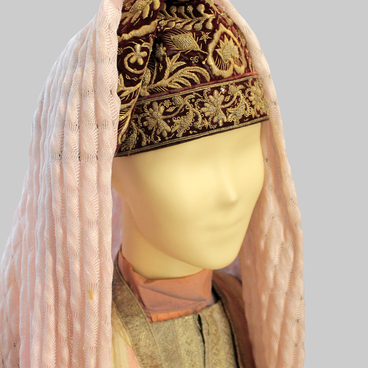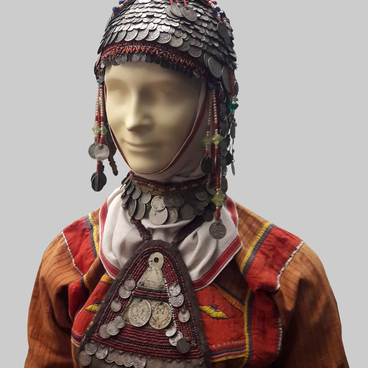The kamzul sleeveless jacket is an integral part of a Tatar woman’s holiday and everyday outfit. Kamzuls (camisoles) were sewn fitted long, down to the knees, or short, down to the hips, either with short sleeves cut off at the elbows or without sleeves, with high sides or with a deep chest cut, with a wrap in front or without one (“end-to-end”). Camisoles were sewn from velvet and other silk and semi-silk fabrics with lining; the edges of the sides, hem, and armholes for the sleeves were decorated with stripes of braiding, galloon, and bird (or swan or other types) of down. It is typical that there is no embroidery on traditional camisoles, although patterned silk fabrics, such as brocade, are used to sew them.
The camisole was worn over a dress, and it was part of a holiday outfit. To give the back more tightness, it was cut from two halves (with a vertical axial seam in the middle of the back) that expanded from the waist to the hips through side wedges; the central and two side seams formed folds (the three-seam camisole).
The camisole was worn over a dress, and it was part of a holiday outfit. To give the back more tightness, it was cut from two halves (with a vertical axial seam in the middle of the back) that expanded from the waist to the hips through side wedges; the central and two side seams formed folds (the three-seam camisole).
Young women sewed their camisoles with five seams. To do this, below the opening of the sleeves to the hem, or only running from the openings to the waist (if the width of the fabric allowed, the sides were fitted without a wedge), additional inserts were made.
The width of the camisoles along the hem ranged from 170 to 230 centimeters. Wealthy Tatar women had camisoles up to 360 centimeters wide.
Unlike the Kazan Tatars, for the Kryashen people camisoles were the daily clothing for young women. For the sake of decency, during the first year of marriage she had to wear a camisole all the time. These camisoles were sewn long (down to the knees), with high sides (with a closed chest), and were worn with an apron.
From the late 19th to the early 20th centuries, girls wore short (hip-length), tight-fitting, camisoles that were sometimes single-breasted, meaning without a wrap (end-to-end). This version of the camisole, influenced by European fashion, lost some of the features of the traditional camisole worn by the Tatar people. The most common camisole colors were black, green, various shades of red, and yellow. Some fashionable women ordered camisoles made from the same fabric as dresses.
The fitted camisole from the museum’s collection has a three-seam back, sewn of silk fabric in pale pink and pale golden vertical stripes. The lining is a brown semi-silk fabric. There are inserts that start from the armholes. The hem is flared with small gussets. The armholes, flaps, and hem are trimmed with golden braiding. Faux pockets are sewn to the camisole, which are also trimmed with braid.
The width of the camisoles along the hem ranged from 170 to 230 centimeters. Wealthy Tatar women had camisoles up to 360 centimeters wide.
Unlike the Kazan Tatars, for the Kryashen people camisoles were the daily clothing for young women. For the sake of decency, during the first year of marriage she had to wear a camisole all the time. These camisoles were sewn long (down to the knees), with high sides (with a closed chest), and were worn with an apron.
From the late 19th to the early 20th centuries, girls wore short (hip-length), tight-fitting, camisoles that were sometimes single-breasted, meaning without a wrap (end-to-end). This version of the camisole, influenced by European fashion, lost some of the features of the traditional camisole worn by the Tatar people. The most common camisole colors were black, green, various shades of red, and yellow. Some fashionable women ordered camisoles made from the same fabric as dresses.
The fitted camisole from the museum’s collection has a three-seam back, sewn of silk fabric in pale pink and pale golden vertical stripes. The lining is a brown semi-silk fabric. There are inserts that start from the armholes. The hem is flared with small gussets. The armholes, flaps, and hem are trimmed with golden braiding. Faux pockets are sewn to the camisole, which are also trimmed with braid.



